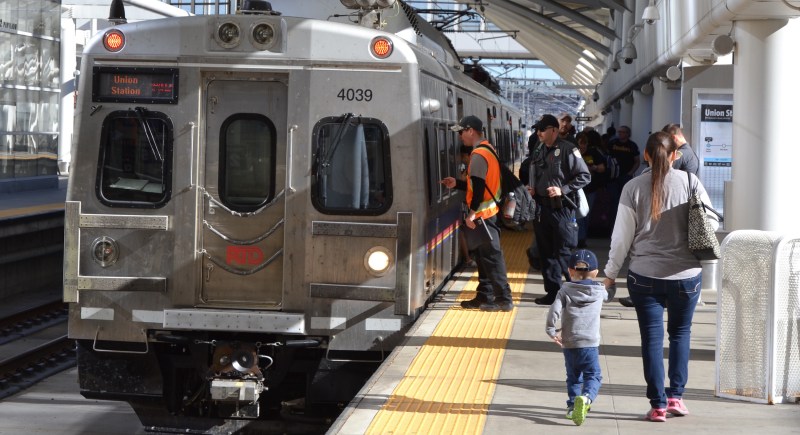The Overhaul of RTD’s Fare Pass Programs, Explained
Callibrating current passes, nixing old options, and adding new ones might raise ridership, but not everyone is happy.

For the past year, a group of decision-makers in the transportation arena has been trying to increase access and ridership on the RTD transit system without digging any deeper into the underfunded agency’s pockets. The vehicle? An overhaul of RTD’s confusing and unfair fare pass programs.
The Pass Program Working Group’s deliberations ended Tuesday. The process required modeling countless combinations of fare discounts, price increases, and ridership projections, among other factors — and jockeying from affordable transit advocates, business groups, college reps, city transportation officials, educators, and RTD itself.
Here’s one scenario (out of hundreds) that gets at the complexity of this “Good Will Hunting” math problem: To create a pass for residents on a tight income, RTD needs more money, and that money has to come from somewhere. So what if RTD “right-sized” the CollegePass? In other words, got rid of discounts for universities that buy the passes in bulk, and charged them for the trips students and faculty actually take. It could work, but it could also cause disgruntled learning institutions to drop off, meaning ridership (and revenue) will suffer.
The group will pitch the recommendations (which might still change) to General Manager Dave Genova next week. Eventually the elected Board of Directors will have to vote on the package. Here’s a high-level view of where the dust settled today.
A 40 percent discount for low-income riders
Transit is a lifeline for a lot of people, but not everyone can afford to ride RTD, whose sprawling system costs riders more here than in peer cities.

The group will recommend a 40 percent discount pass for people who live at 185 percent of the federal poverty level. So a family of four making about $46,000 or less would qualify, according to federal guidelines.
Transit advocates from Mile High Connects and 9to5 Colorado say a 50 percent discount is critical. The working group will include language in its recommendation that encourages RTD to provide a half-off fare at some unknown point, but the group won’t officially get behind it because they couldn’t make the numbers work.
Some kids ride free, others get a 70 percent discount
Riders age 12 and under would ride fare-free. Thirteen to 19-year-olds would get a pass good for 70 percent off the standard fare. Institutions including Denver Public Schools would administer the passes.
Calibrating the EcoPass and CollegePass
Some businesses get bargain basement deals and others get the shaft when they buy EcoPasses in bulk. That’s because different companies have employees using the system in different ways — some may use RTD everyday and travel 20 miles, while others may use it rarely and travel two miles, but the cost of the programs to employers don’t always align with reality.
Businesses that provide EcoPasses would pay RTD a fee that’s more in line with how employees are using the system, so the price will rise for some and fall for others in what some working group members have called “right-sizing.” The exact formula is still being discussed.
Under the new setup, RTD will base the CollegePass pricing on how people actually used the transit system in 2016 — an estimated 20 percent increase in price over three years. The risk here is that the University of Colorado, for instance, won’t be incentivized to provide passes as a benefit for students.
A system-wide fare hike?
Every few years RTD revisits its fare prices and considers adjusting them. The group assumed a 2019 local, one-way fare of $3 (a 40 cent increase) and a regional fare of $5.25 (a 75 cent increase) to make the math work.
Transit advocates from 9to5 Colorado say a fare increase undercuts any affordability in-need residents would get — but the recommendation could also very well keep the hike from going any higher a year from now.
A more flexible ride
Transfers as we know them will be gone. In their place, riders will have a three-hour window to travel in any direction for the price of a single-trip fare.
Will more people ride buses and trains as a result?
Despite the Denver region’s massive population growth and the opening of the A, B, and R lines, RTD’s ridership has dropped for four years straight. The new suite of transit passes — combined with other adjustments, like scrapping discounts for people who use the MyRide card and the 10-ride ticket book — could change that.

Ridership is a key metric for transit agencies because it reflects the quality of their service. The changes would see ridership grow 2 percent faster than if the pass program remained the same, according to the number crunchers, in part because of increased access for low-income riders. The new suite of passes would equate to an estimated 100 million annual boardings in 2019 and 104 million in 2021.
Those numbers are lower than RTD’s ridership in 2014 (about 105 million). They’re also based on a lot of ifs: Will enough colleges and businesses keep their contracts with RTD after prices change? Will businesses continue to offer transit passes as benefits? Will the N Line open on time?
Money left on the table?
One thing group members were ordered not to assume in their recommendations? Policy changes that would provide RTD with more funding, including a potential bill in the state legislature that would raise $10 million annually for affordable fares.
This article has been updated.


